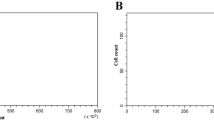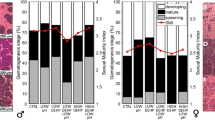Abstract
Widespread use of the herbicide atrazine has incited much research on its toxicity in aquatic systems, where it is routinely detected due to runoff from cultivated fields. Moreover, the determination of the genotoxic effect of such pollutants in the marine environment has become a major requirement for ecosystem protection. In the Pacific oyster, Crassostrea gigas, hypodiploid aneuploid cells have regularly been reported. There is a negative correlation between this phenomenon and growth, as well as evidence for a genetic basis. A positive relationship between atrazine and aneuploidy has previously been demonstrated in C. gigas adults and juveniles. To evaluate the persistence of this impact, our study examined the offspring of the same adult population previously treated with different atrazine doses (10 µg l−1, representing a peak value found in a polluted environment and 100 µg l−1), and a seawater control. We observed that these offspring exhibited significantly higher aneuploidy levels when their parents had been exposed to atrazine (14.9–16.9% in comparison with the control where the levels ranged from 11.4% to 12.8%). In addition, the present study examined the aneuploidy level of a sample of juveniles, previously exposed for 3.5 months to the same doses of atrazine, then transferred to non-polluted conditions for an additional period of 2.5 months; this aneuploidy level remained significantly different between the treatments applied. These results demonstrate the persistence of an atrazine impact on Pacific oyster aneuploidy in time, within and between generations, indicating that this widely used compound may represent an important factor causing at least medium-term damage to genetic material.





Similar content being viewed by others
References
Ahmed M, Sparks AK (1970) Chromosome number, structure and autosomal polymorphism in the marine mussels Mytilus edulis and Mytilus californianus. Biol Bull (Woods Hole) 138:1–13
Allran JF, Karasov WH (2001) Effects of atrazine on embryos, larvae and adults of anuran amphibians. Environ Toxicol Chem 20:769–775
Auffret M, Oubella R (1997) Hemocyte aggregation in the oyster Crassostrea gigas: in vitro measurement and experimental modulation by xenobiotics. Comp Biochem Physiol A 118:705–712
Bond DJ, Chandley AC (1983) Aneuploidy. Oxford Monographs on Medical Genetics no. 11, Oxford University Press, Oxford
Bouilly K, Leitão A, McCombie H, Lapègue S (2003) Impact of atrazine on aneuploidy in Pacific oysters, Crassostrea gigas. Environ Toxicol Chem 22:219–223
Dixon DR (1982) Aneuploidy in mussel embryos (Mytilus edulis L.) originating from a polluted dock. Mar Biol Lett 3:155–161
Dixon DR, Wilson JT (2000) Genetics and marine pollution. Hydrobiologia 420:29–43
Galloway TS, Depledge MH (2001) Immunotoxicity in invertebrates: measurement and ecotoxicological relevance. Ecotoxicology 10:5–23
Huber N (1993) Ecotoxicological relevance of atrazine in aquatic systems. Environ Toxicol Chem 12:1865–1881
Legendre P, Legendre L (1998) Numerical ecology. Elsevier Science, Amsterdam
Lehotay SJ, Harman-Fetcho JA, McConnell LL (1998) Agricultural pesticide residues in oysters and water from two Chesapeake Bay tributaries. Mar Pollut Bull 37:32–44
Leitão A, Boudry P, McCombie H, Gérard A, Thiriot-Quiévreux C (2001a) Experimental evidence for a genetic basis to differences in aneuploidy in the Pacific oyster (Crassostrea gigas). Aquat Living Resour 14:233–237
Leitão A, Boudry P, Thiriot-Quiévreux C (2001b) Evidence of differential chromosome loss in aneuploid karyotypes of the Pacific oyster, Crassostrea gigas. Genome 44:735–737
Leitão A, Boudry P, Thiriot-Quiévreux C (2001c) Negative correlation between aneuploidy and growth in the Pacific oyster Crassostrea gigas: ten years of evidence. Aquaculture 193:39–48
Li XX, Havenhand JN (1997) Karyotype, nucleolus organiser regions and constitutive heterochromatin in Ostrea angasi (Molluscae: Bivalvia): evidence of taxonomic relationships within the Ostreidae. Mar Biol 127:443–448
Longwell AC, Stiles SS, Smith DG (1967) Chromosome complement of the American oyster Crassostrea virginica as seen in meiotic and cleaving eggs. Can J Genet Cytol 9:845–856
Marchini S, Passerini L, Cesareo D, Tosato ML (1988) Herbicidal triazines: acute toxicity on Daphnia, fish and plants and analysis of its relationships with structural factors. Ecotoxicol Environ Saf 16:148–157
Martin RH, Rademaker A (1990) The frequency of aneuploidy among individual chromosomes in 6,821 human sperm chromosome complements. Cytogenet Cell Genet 53:103–107
Martínez-Expósito MJ, Martínez-Lage AA, Pasantes JJ, Méndez J (1992) A preliminary study of aneuploidy in natural populations in the genus Mytilus. Cuad Cienc Mar Sem Estud Galegos 6:49–55
Moraga D, Tanguy A (2000) Genetic indicators of herbicide stress in the Pacific oyster Crassostrea gigas under experimental conditions. Environ Toxicol Chem 19:706–711
Munschy C (1995) Comportement géochimique des herbicides et de leurs produits de dégradation en milieu estuarien et marin côtier. PhD thesis, Université de Paris 6, Paris, France
Rivière JL (2001) Ecotoxicological and toxicological aspects of pesticides: from regulatory risk assessment to environmental monitoring. Pesticides transfer diagnosis and corrective solutions. Cemagref, Antony, France, no. HS, pp 23–27
Robert R, His E, Maurer D (1986) Toxicité d’un desherbant, l’atrazine-simazine, sur les jeunes stades larvaires de Crassostrea gigas et sur deux algues fourrages Isochrysis aff-galbana et Chaetoceros calcitrans. Haliotis 15:319–325
Scherrer B (1984) Biostatistique. Gaëtan Morin, Montreal
Shelton AD, Miller MC (2002) Herbicide bioconcentration in Cladophora glomerata: atrazine removal in a eutrophic agricultural river. Hydrobiologia 469:157–164
Sokal RR, Rohlf FJ (1995) Biometry. Freeman, New York
Solomon KR, Baker DB, Richards RP, Dixon KR, Klaine SJ, La Point TW, Kendall RJ, Weisskopf CP, Giddings JM, Giesy JP, Hall LW Jr, Williams WM (1996) Ecological risk assessment of atrazine in North American surface waters. Environ Toxicol Chem 15:31–76
Steinert SA, Streib-Montee R, Leather JM, Chadwick DB (1998) DNA damage in mussels at sites in San Diego Bay. Mutat Res 399:65–85
Thiriot-Quiévreux C (1986) Etude de l’aneuploïdie dans différents naissains d’Ostreidae (Bivalvia). Genetica 70:225–231
Thiriot-Quiévreux C, Ayraud N (1982) Les caryotypes de quelques espèces de bivalves et gastéropodes marins. Mar Biol 70:165–172
Thiriot-Quiévreux C, Pogson GH, Zouros E (1992) Genetics of growth rate variation in bivalves: aneuploidy and heterozygosity effects in a Crassostrea gigas family. Genome 35:39–45
US Environmental Protection Agency (1994) Pesticides industry sales and usage: 1992 and 1993 market estimates. EPA 733-K-94-001, Washington, DC
Verma RS (1990) The genome. VCH, New York
Wilkinson L (1990) SYSTAT: the system for statistics. SYSTAT, Evanston, Ill., USA
Acknowledgements
Part of this research was supported by the Conseil Général of Charente-Maritime, the Programme Environnement, Vie et Sociétés from CNRS and the Région Poitou-Charentes (Plan Etat-Région 2001-RPC-A-212 and 2002-RPC-A-180). We thank R.B. Hamadou for statistical analysis. All experiments comply with French law.
Author information
Authors and Affiliations
Corresponding author
Additional information
Communicated by S.A. Poulet, Roscoff
Rights and permissions
About this article
Cite this article
Bouilly, K., McCombie, H., Leitão, A. et al. Persistence of atrazine impact on aneuploidy in Pacific oysters, Crassostrea gigas . Marine Biology 145, 699–705 (2004). https://doi.org/10.1007/s00227-004-1369-8
Received:
Accepted:
Published:
Issue Date:
DOI: https://doi.org/10.1007/s00227-004-1369-8




